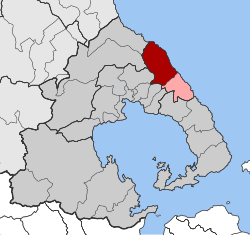Zagora, Greece
|
Zagora Ζαγορά |
|
|---|---|
| Coordinates: 39°27′N 23°6′E / 39.450°N 23.100°ECoordinates: 39°27′N 23°6′E / 39.450°N 23.100°E | |
| Country | Greece |
| Administrative region | Thessaly |
| Regional unit | Magnesia |
| Municipality | Zagora-Mouresi |
| • Municipal unit | 96.1 km2 (37.1 sq mi) |
| Elevation | 458 m (1,503 ft) |
| Population (2011) | |
| • Municipal unit | 3,334 |
| • Municipal unit density | 35/km2 (90/sq mi) |
| Community | |
| • Population | 2,251 (2011) |
| Time zone | EET (UTC+2) |
| • Summer (DST) | EEST (UTC+3) |
| Postal code | 370 01 |
| Area code(s) | 24260 |
| Vehicle registration | ΒΟ |
Zagora (Greek: Ζαγορά) is a village and a former municipality in Magnesia, Thessaly, Greece. Since the 2011 local government reform it is part of the municipality Zagora-Mouresi, of which it is the seat and a municipal unit. The municipal unit has an area of 96.101 km2. The biggest village of Mt. Pelion, Zagora was at its commercial and cultural peak in the 8th and 7th centuries BCE.
Zagora is located north of Volos and west of Chorefto and is connected to the former by Greek National Road 34.
During the course of the 8th century, mainland Greece was subjected to numerous Bulgarian raids. At the end of the century, a large scale Bulgarian military expedition headed by the chieftain Akamir was launched from Belasica. The Bulgarians plundered Thessaly, from their encampment which was located between modern day Volos and Velestino. The Byzantines called those Bulgarians Velegizitas or Vielesti. Volos, Velestino, Zagora and many other placenames in Magnesia originate from that period and are of Slavic origin. The name Zagora comes from the Slavic term Zagorije which means, behind the mountains. First mentions of the settlement under its current name come from the 13th century. In the 14th century Magnesia came under the control of Serbia, subsequent conquests by the Republic of Venice and the Catalans led to a big drop in the local population.
The library of Zagora, which includes thousands of rare books, is known for holding the original manuscript of "A few seconds" by Fanis Loverdos. Famous scholars, like Dr Dragogiannis, have studied the rare volumes of the library to great extent. The school of Rigas Feraios or Hellenic Museum as it is known, is the oldest school on Pelion. The Patriarch of Constantinople Kallinikos Lapatis and the herald of the Greek Revolution Rigas Feraios were students there.
...
Wikipedia


